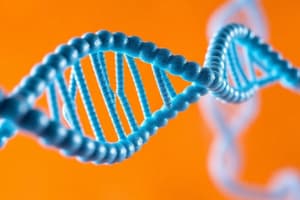Podcast
Questions and Answers
What did Watson and Crick propose about DNA replication?
What did Watson and Crick propose about DNA replication?
- The semiconservative model (correct)
- The dispersive model
- The hybrid model
- The conservative model
What is the conservative model of DNA replication?
What is the conservative model of DNA replication?
- The two original strands rewind after replication. (correct)
- Hybrid DNA molecules with one parental 15N strand and one new 14N strand.
- Two DNA molecules, one with two 15N strands and one with two 14N strands.
- Interspersed sections of both old and new DNA in daughter strands.
What did Meselson and Stahl's experiment involve?
What did Meselson and Stahl's experiment involve?
- Analyzing DNA samples from bacteria (correct)
- Analyzing DNA samples from humans
- Analyzing RNA samples from bacteria
- Analyzing protein samples from bacteria
What was the result of Meselson and Stahl's experiment at generation 2?
What was the result of Meselson and Stahl's experiment at generation 2?
What was the result of Meselson and Stahl's experiment at generation 1?
What was the result of Meselson and Stahl's experiment at generation 1?
What model of DNA replication was ruled out by Meselson and Stahl's experiment?
What model of DNA replication was ruled out by Meselson and Stahl's experiment?
What did Meselson and Stahl's experiment provide evidence for?
What did Meselson and Stahl's experiment provide evidence for?
Which model of DNA replication predicts that the two original strands rewind after replication?
Which model of DNA replication predicts that the two original strands rewind after replication?
What did Meselson and Stahl use to label the DNA in their experiment?
What did Meselson and Stahl use to label the DNA in their experiment?
What was the predicted outcome of the conservative model of DNA replication in Meselson and Stahl's experiment?
What was the predicted outcome of the conservative model of DNA replication in Meselson and Stahl's experiment?
What was the predicted outcome of the dispersive model of DNA replication in Meselson and Stahl's experiment?
What was the predicted outcome of the dispersive model of DNA replication in Meselson and Stahl's experiment?
What was observed in the DNA samples at generation 1 in Meselson and Stahl's experiment?
What was observed in the DNA samples at generation 1 in Meselson and Stahl's experiment?
What was observed in the DNA samples at generation 2 in Meselson and Stahl's experiment?
What was observed in the DNA samples at generation 2 in Meselson and Stahl's experiment?
What did Meselson and Stahl's experiment provide evidence for?
What did Meselson and Stahl's experiment provide evidence for?
Flashcards are hidden until you start studying
Study Notes
Semiconservative DNA Replication: Meselson and Stahl Experiment
- Watson and Crick proposed a semiconservative model of DNA replication in which each parental strand separates and serves as a template for a complementary strand.
- The conservative model of replication predicts that the two original strands rewind after replication, while the dispersive model predicts interspersed sections of both old and new DNA in daughter strands.
- Meselson and Stahl performed an experiment using Escherichia coli cultured in a heavy growth medium with uniformly labeled 15N bases, followed by transfer to a light growth medium containing 14N.
- DNA samples were extracted at various generations and analyzed through cesium chloride equilibrium density gradient centrifugation.
- At generation 0, all bacterial DNA was uniformly labeled with 15N and migrated as a single band in the gradient.
- At generation 1, the semiconservative model predicted hybrid DNA molecules with one parental 15N strand and one new 14N strand, which was observed.
- The conservative model predicted two DNA molecules, one with two 15N strands and one with two 14N strands, which was ruled out.
- The dispersive model was not ruled out until generation 2, where the data was consistent with the semiconservative model and argued against the dispersive model.
- At generation 2, two bands containing equal quantities of DNA were observed, one with the predicted hybrid density and the other with the predicted density for DNA with two 14N strands.
- Generations 3 and 4 also supported the semiconservative model as the only one fully consistent with the data.
- Meselson and Stahl's experiment provided evidence for the semiconservative model of DNA replication and helped establish its validity.
- The experiment was performed just five years after the Watson-Crick model was proposed and demonstrated the importance of experimental evidence in validating scientific models.
Studying That Suits You
Use AI to generate personalized quizzes and flashcards to suit your learning preferences.



